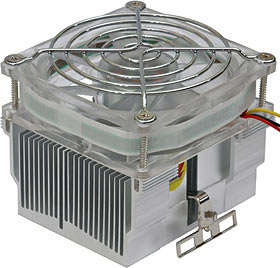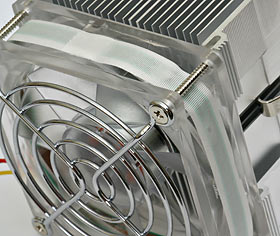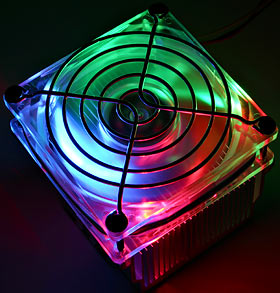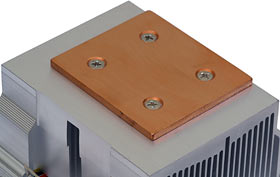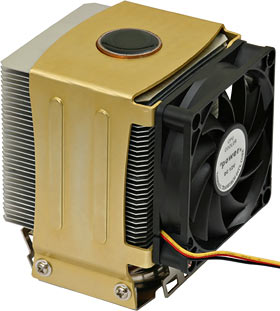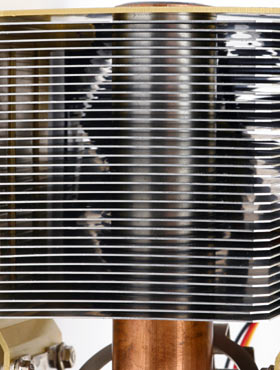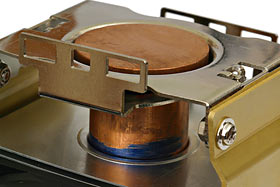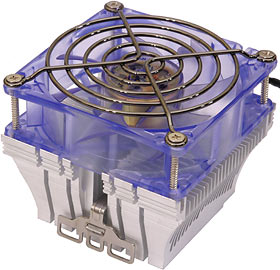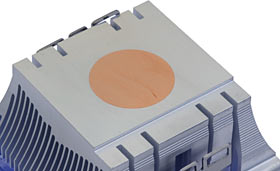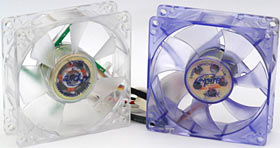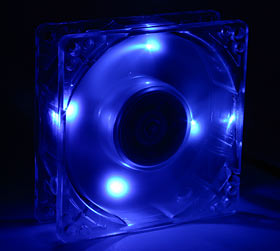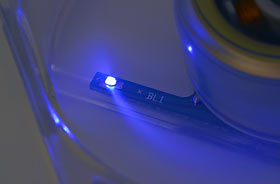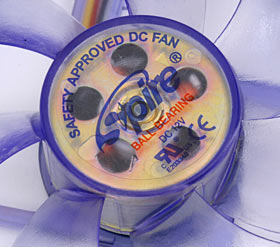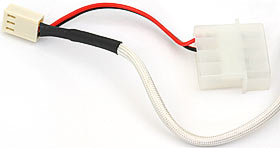
Quick Shot review 4:
Three Socket A CPU coolers
Review date: 18 September 2003.Last modified 03-Dec-2011.
Socket A's days are numbered.
The number still isn't a terribly small one, mind you. AMD may be transitioning to 64 bit chips with three new sockets, but the good old 32 bit Athlon will live on as a budget CPU for some time, and will still be a real high performance contender for most of the rest of this year, at least.
But companies that make Socket-A-specific gear, CPU coolers in particular, are ramping down now. There are already tons of cooler designs out there, covering every market niche; there's not much point designing a bunch of new models for a socket that's not going to be high on PC enthusiasts' shopping list for much longer.
Here, therefore, are three coolers from the rearguard of the Socket A army.
Thermaltake TR2-M1
Thermaltake keep on pumping out new coolers, many of them featuring brightly coloured fans and other styling cues beloved by the stickers-make-my-car-faster market.
At a glance, though, the TR2-M1 doesn't look very special. That's because it's part of Thermaltake's budget TR2 line; its full list price is only about $US20, and it's been spotted for a lot less.
It's got an 80mm fan, though, and that bodes well. All things being equal, 80mm fans move more air, make less noise and last longer than the more common 60mm units.
The TR2-M1's fan is made from translucent plastic, and has a flexible circuit wrapped around it, nicely armoured with cloth tape.
Those who've been keeping up with recent trends in computer decoration will know that a fan that looks like this when it's off...
...is likely to look something like this when it's on.
Three LEDs light it up, with enough brightness that it's very noticeable in a normally lit room at night. If you don't have a side window in your computer case, of course, this feature is unlikely to matter to you.
This is more important. The TR2-M1 has a copper slab attached to the base of its otherwise-all-aluminium heat sink, to spread the heat from the processor contact patch. Many coolers work this way, but the TR2-M1's the first one I've seen whose heat spreader is just screwed onto the base. Undo the screws and you can take the spreader off, once you defeat the gooey thermal compound between it and the bottom of the heat sink.
This extra thermal junction can't possibly transfer heat as well as the better integrated heat spreaders of more expensive CPU coolers, and the fan's only a medium-to-low powered unit, so I wasn't expecting much when I buckled the TR2-M1 onto my CPU simulator (its clip is a perfectly acceptable screwdriver-attach one-piece three-hole unit).
And lo, this cooler scored 0.65°C/W.
That's more than acceptable for low end Socket A processors, pretty much anything that fits in Socket 370, and even for overclocking, as long as your computer case has respectable air flow. But it isn't setting any records.
For the money, the TR2-M1 is a perfectly good cooler, provided you want, or at least don't mind, the goofy glowy fan.
Unlikely contraption department
You're not going to mistake this for any other cooler.
Thermal Transtech specialise in heat pipe cooling systems, and a big fat heat column sits in the middle of their NPH-2. If the central column were made of solid copper then the cooler would be a failure; all those thin aluminium fins would be too darn far, thermally, from the point of heat injection.
But heat pipes change everything, and allow a weird looking cooler like this to work, and work well.
Those fins, in detail. Because they're aluminium, they allow this unusually large cooler (total height about 10 centimetres; owners of pizza-box-case computers need not apply) to weigh a relatively svelte 400 grams, which isn't too terrifying a mass to hang off a CPU socket, especially with a decent clip. The NPH-2 has a quality two-piece three-hole finger-attach retainer.
I still wouldn't be eager to knock over a computer with one of these on its CPU, but knocking over computers is an overrated hobby anyway.
The NPH-2's single fan blows horizontally; it's a 70mm slimline medium-low power unit of no particular distinction.
The base of the NPH-2 looks almost as odd as the rest of it. The round butt of the heat column sticks out of a steel plate, which it's attached to in such a way that a "moat" surrounds it. The column also stands very slightly proud of the plate. That made me nervous, so I did a few measurements to see whether this cooler was likely to be a CPU Core Crusher, like some other round-base models.
The diagonal distance between the four rubber anti-disaster dots that surround the core of a Socket A CPU is about 47mm. The base of the NPH-2 heat column is less than 34mm in diameter. This is narrow enough that the dots should fall on the other side of the moat, all around the column, and the column's elevation above the surrounding plate is small enough that the dots should be able to do their job.
If the NPH-2 clip could slide back and forth and thus let you install the cooler so that a couple of dots fell into the moat, then it'd be a disaster looking for a place to happen. Fortunately, the clip has a hinge arrangement in the middle that keeps it neatly in place. So as long as you don't manage to put the thing on backwards, it ought to be fine.
On with the testing. When I warmed the system up with the NPH-2's fan turned off, the top of its heat column got hot fast, which was a very good sign. It didn't prepare me for the result I got when I turned the fan on and let the system settle down to a reading, though.
The NPH-2 managed 0.49°C/W, which isn't far away from the best result I've ever seen from an air cooler, and which beats into a cocked hat everything else that's got a reasonably quiet fan.
So, I hear you ask, what does it do with a more powerful 70mm fan. A TMD fan, for instance?
It does 0.45°C/W, that's what it does. A worthwhile further improvement, and one that brings this cooler up to the level of the most deafeningly outrageous of conventional coolers (like this, for instance), despite being only medium-loud.
I tested the NPH-2 with it sitting vertically on my CPU simulator. That's not the way it'll be installed in most PCs; tower-case computers have vertical motherboards. Most CPU coolers don't care about alignment, but heat pipe models can, if they've got the simple kind of heat pipe that's just refrigerant in a tube. Those kinds of heat pipes have to operate with the hot end lower than the cold end; otherwise the liquid refrigerant inside just pools up at the lower, colder end and the gas/liquid cycle that shifts the heat doesn't happen.
To solve this problem, you have to put a wick of some kind inside the heat pipe, so liquid refrigerant can flow back uphill to the hot end if it has to. Most heat pipes have wicks.
Thermal Transtech's page explaining their heat pipes shows wicks in them, but I thought I'd better check, anyway. Rather than rotate my test rig, I just turned the NPH-2 over in my lap and assaulted its base with a butane torch, while resting my fingers on the other end of the heat column.
Yup, it's got a wick.
It probably won't work quite as well if it doesn't have gravity helping the refrigerant to get back to the hot end of the pipe, but it'll still perform.
So this isn't just a cooler for The Geek Who Has To Be Different. It's a genuine top-flight contender. Highly recommended.
UPDATE: Australian shoppers can now buy the NPH-2, and its similarly excellent Pentium 4 cousin the NPH-1, from Aus PC Market. They cost $AU77, including delivery anywhere in Australia.
Click here for the NPH-2; click here for the NPH-1.
Whisper who dares
And now, something a bit more conventional.
This is Spire's WhisperRock IV, the successor to their popular FalconRock coolers.
This WhisperRock came to me from LowNoise PC here in Australia, who sell it for $AU35. Another cheap cooler, in other words, particularly when you consider its good-sized heat sink and 80mm fan.
The WhisperRock IV has the same aluminium heat sink (with inlaid heat spreader) as the earlier FalconRock II (reviewed here), but it replaces the FalconRock's decorative aluminium-framed fan with a quieter translucent blue unit (not equipped with any little lights), which is alleged to have the same performance. It's got the same nominal 1.08 watt power rating, too - that doesn't necessarily mean the two fans actually draw the same current when running, though.
The new fan sure is quiet, to the point of practical inaudibility if it's tucked away inside a PC case. Silent computing enthusiasts should have nothing to complain about. They wouldn't have minded the FalconRock II either, though. Yes, there's a difference, but it's trivially small, if you ask me.
The new fan isn't, however, quite as effective as the old one, at least according to my tests.
The FalconRock II managed 0.63°C/W when I tested it with its stock fan, which is extremely good for such a quiet cooler. It also managed spectacularly good scores when I tried it with more powerful fans. With a moderately loud fan on it, this heat sink is a serious overclocker's cooler.
The WhisperRock IV, though, only managed 0.67°C/W when I tested it with its standard, quieter fan. That's perfectly adequate for many purposes, and a good result for such a low noise level, but it's not amazing.
As you'd expect, though, the WhisperRock did just as well with other fans as the FalconRock II.
Not these ones, though.
LowNoise PC sell these fans, too; they're another couple of Spire products. The one on the right is a super-quiet one-watter, almost the same as the fan on the WhisperRock IV. The one on the left has a mighty 1.8 watt rating, but that's only because...
...it does this.
This LED-lit fan has its LEDs on little outriggers...
...so they shine out through the blades, instead of tangentially through them.
This is a neat design, if you want a fan that throws air one way and light the other. The LEDs are little surface mount units with no focusing lenses, though, so you don't get a flashlight beam from the thing.
Unfortunately, Spire have apparently switched to making (or rebadging...) LED fans with an ordinary lights-around-the-rim design now, though; LowNoise PC don't have any stock of the outrigger type any more.
Lights aside, these two fans are supposed to have slightly different airflow specs, as a result of their different blade design. The LED fan has plain truncated-triangle blades, while the other one has curved blades that're no doubt meant to be the source of its superior noise-versus-airflow performance.
But I couldn't detect an obvious difference, and they both seem to have much the same motor assembly...
...though the non-LED fan has these neat-o viewing holes, while the other one has the whole top of the can inside the hub cut away.
More practically, these fans come with pleasing dual-plug cables.
No more fiddling around with four-to-three-pin plug adapters, folks; just plug in whichever one suits you. It's this arrangement that makes the plain blue fan different from the one that comes on the WhisperRock IV; that fan's cable only has a three-pin plug.
All of the fan cables, by the way, are sheathed with a white woven tube that may do something to protect them from damage, but mainly just looks natty.
I'd be unexcited about the Spire fans if they were expensive, but they only cost $AU16 and $AU17, for the LED-lit and non-lit versions, respectively. That's right - the unlit fan costs more. Don't ask me why.
Anyway, they're cheap, they're quiet, they've got good twin plugs, and the LED-lit one looks neat too (though the ones on sale now look less neat, because of their conventional LED layout).
But these fans don't move any more air than the WhisperRock IV's stock fan. I had to swap in something noisier to get it to deliver the superb results I'd seen from the identical heat sink from the FalconRock.
LowNoise PC would be betraying their name if they sold anything with a noisy fan on it, of course; the WhisperRock IV is a super-quiet cooler, and one or both of the two Spire fans would be a good choice for case ventilation in a WhisperRock-equipped PC.
Taking the price into account, this little lot of Spire gear gets a "Recommended" from me.
Thermaltake TR2-M1 kindly provided by Thermaltake.
Thermal Transtech NPH-2 kindly provided by Thermal Transtech.
Spire WhisperRock IV kindly provided by LowNoise PC.
